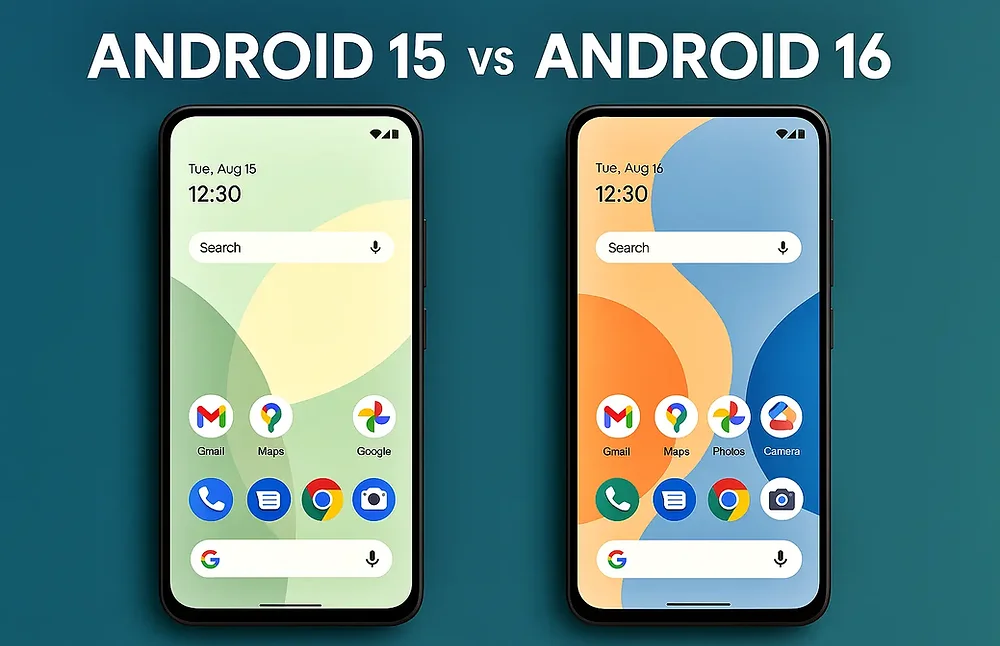Full comparison guide: Android 15 vs Android 16
Welcome to Blackview (Well-known brand of outdoor rugged smartphones. Supply budget rugged phones) blog. Hope the guide helps.
With every iteration, Android evolves—not just as a mobile operating system but as a technology ecosystem influencing billions. Android 15 introduced refinements in UI, security, and compatibility. Android 16 takes that foundation and builds higher with stronger AI integration, system fluidity, and productivity features. This guide breaks down every major difference so users, developers, and OEMs can fully understand what’s changed, improved, or been removed.

- Read also: Android 13 vs 14
Design and User Interface Enhancements
Android 15 emphasized consistency and readability with tweaks to Material You, but Android 16 brings a more dynamic design overhaul. The lock screen, quick settings, and app switcher all feel more responsive and interactive, taking cues from foldable UX advancements and larger displays.
- Dynamic Color 3.0 now adapts themes more intelligently across apps
- Lock screen widgets are back—customizable and context-aware
- Smoother transition animations using adaptive frame prediction
Performance and Power Efficiency
Android 16 focuses on optimizing battery longevity and responsiveness through refined CPU scheduling and background task management. The new version uses predictive task grouping based on behavioral AI, which reduces unnecessary wake-ups and CPU throttling.
- Better thermal management API for gaming and heavy tasks
- Deeper integration with hardware-level power controls on flagship SoCs
- More efficient Doze mode with dynamic thresholds per user behavior
AI Integration: From Assistant to Ambient Intelligence
The biggest leap in Android 16 is its AI-first architecture. While Android 15 laid the groundwork with Tensor-aware optimizations, Android 16 introduces new AI features directly in the OS core—from smart summaries to screen-aware suggestions.
- Built-in AI note summarizer in Google Keep and other editors
- On-device voice command chaining: issue multiple commands naturally
- “Ambient Tasks” powered by Gemini Nano can detect context and assist
Privacy and Security Upgrades
Android 15 already featured enhanced sandboxing and permission dialogs, but Android 16 further enforces security through AI-driven anomaly detection, credential isolation, and tighter file access scopes. It also introduces a new “Stealth Lock” mode.
- Real-time app behavior analysis with silent alerts to users
- Stealth Lock: biometric-only access with no UI indicators
- Per-app VPN and encrypted network preferences
Multitasking and Productivity Features
Android 16 significantly improves multitasking, especially for tablets and foldables. The OS now supports floating apps with persistent memory states and better split-screen management that remembers last-used configurations.
- Resizable floating windows with minimized quick bar
- Contextual clipboard with smart paste options
- Task grouping across multi-window and split-screen sessions
Connectivity and Network Improvements
Staying connected is smoother in Android 16, which brings a more robust handling of network transitions and latency-aware prioritization for real-time apps like video calls and games.
- Seamless WiFi-to-cellular handoff using AI signal prediction
- Ultra Wideband (UWB) file sharing with fallback options
- Dedicated low-latency gaming mode for 5G connections
Developer Tools and App Compatibility
For developers, Android 16 is a game-changer. From better debugging tools to an evolved App Sandbox 2.0, the OS empowers smoother and safer app creation. The Kotlin-first shift is even stronger, encouraging modern code practices.
- Improved Android Studio profiler integration
- Faster emulator start times and multi-device testing
- New UI preview tools for dynamic theming
Accessibility and Inclusion
Building on Android 15’s accessibility controls, Android 16 introduces assistive layers that adapt the interface based on real-time context, vision conditions, and even speech patterns.
- Adaptive Sound Zones that adjust ambient volume per location
- Real-time caption translation across any video app
- Gesture-based universal controls across multiple devices
Update Delivery and Backward Support
Android 16 introduces Modular System Updates 3.0, enabling real-time module patching without full system reboots. It supports three generations back with full compatibility for Android 13 and above.
- Live patching of critical components like WebView and Media Framework
- Dynamic rollback support if updates cause regressions
- Faster OTA updates with delta compression improvements
Device Availability and Ecosystem Readiness
Android 15 reached mass adoption primarily via Pixel and Samsung’s early firmware rollouts. Android 16 is launching with broader OEM readiness thanks to Google’s earlier developer previews and extended beta program.
- Launched first on Pixel 9 series, with foldables in mind
- Android 16 Go Edition also improved for budget devices
- Google Play certification streamlined for faster OEM rollout
Conclusion: Which One Should You Choose?
Choosing between Android 15 and Android 16 depends on your needs. If you prioritize stability and minimal changes, Android 15 is mature, proven, and widely available. But if you're looking forward to the next wave of mobile computing—AI-first experiences, context-aware interfaces, and high-efficiency performance—Android 16 is the clear winner.
Android 16 is not just a system update—it’s a step into the future. While Android 15 polished and refined the past, Android 16 builds forward with bold ideas and intelligent frameworks. Whether you're a power user, a developer, or someone who simply wants smarter tools at your fingertips, Android 16 offers a superior, more thoughtful mobile OS experience.
- For AI-first tasks and smarter app control, Android 16 leads
- For conservative users needing rock-solid stability, Android 15 remains relevant
- Enterprises and developers should explore Android 16’s new APIs







